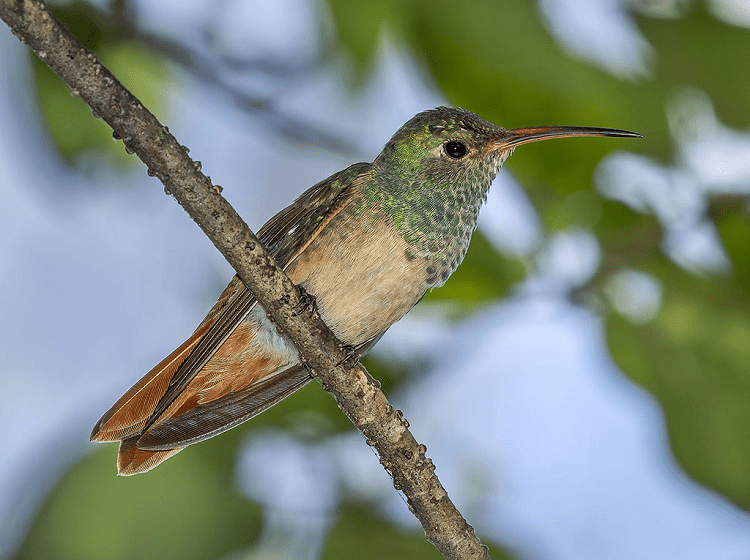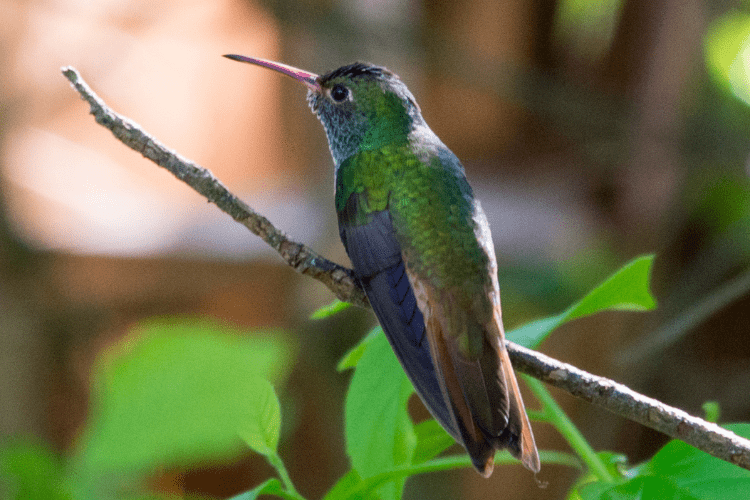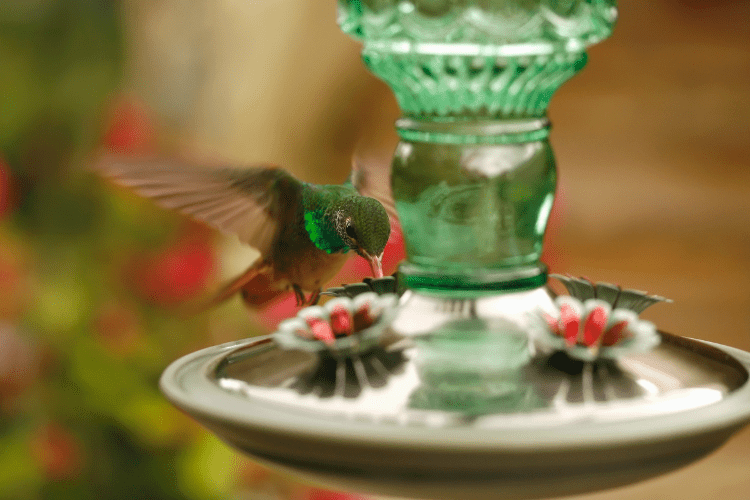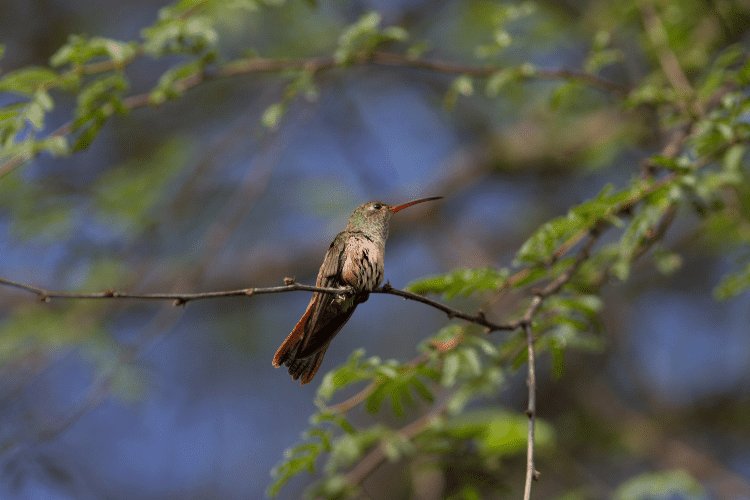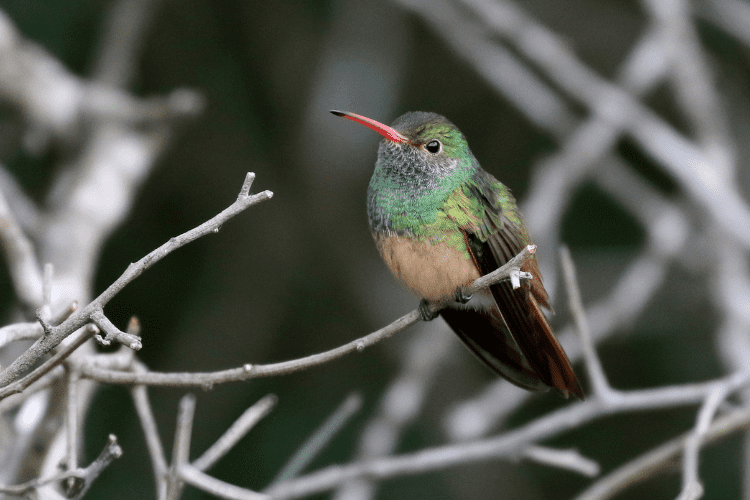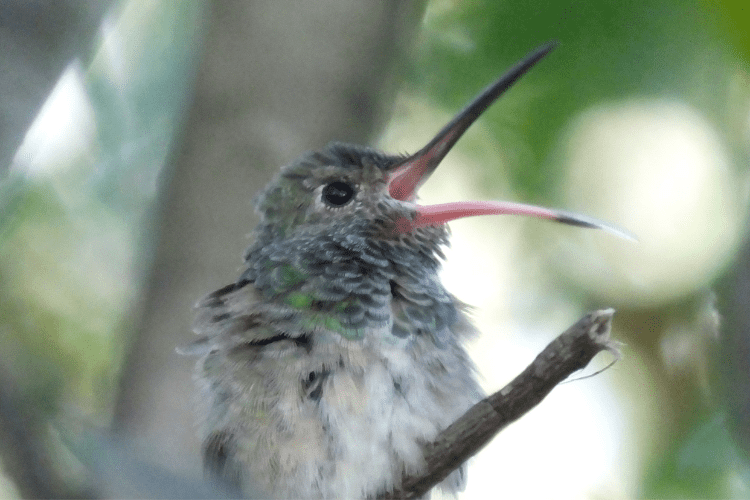- Buff-bellied Hummingbird Guide - November 12, 2022
- Broad-billed Hummingbird Guide (Cynanthus latirostris) - November 8, 2022
- Red-naped Sapsucker Guide (Sphyrapicus nuchalis) - November 1, 2022
The naming of birds has always been interesting to me. Some birds are named after people, such as the Cooper’s Hawk (named after 19th-century naturalist William Cooper), or Bonaparte’s Gull (named after Prince Charles Lucien Bonaparte, who happened to be the nephew of Napoleon Bonaparte!).
Alexander Wilson, considered by many to be the Father of American Ornithology, actually has five birds named after him – Wilson’s Warbler, Wilson’s Storm-Petrel, Wilson’s Snipe, Wilson’s Phalarope, and Wilson’s Plover.
Some birds are named after a sound they make (like the Bobwhite, Killdeer, and Chickadee). Other birds are named for locations. Birds named in this way include the Canada Goose, California Quail, Mississippi Kite, and Virginia Rail.
However, my favorite bird names (and in my opinion the most practical) are those that simply describe the bird or at least some feature of it. These names make the most sense and can be helpful when you are trying to identify a particular bird. For example, Goldfinches are, in fact, gold (or at least bright yellow), and Red-Naped Sapsuckers do have a red patch on their nape.
Red-tailed Hawks do have a reddish tail when you see them flying overhead., and Red-winged Blackbirds are black birds with red on their wings (unless you see a female or juvenile… then all bets are off!). When I see one of these birds and consider their name, I think to myself “Yep, that name makes sense!”.
The Buff-bellied Hummingbird is another such bird, so named because its belly is a creamy buff color. This little bird is one of the fifteen or so hummingbird species that make some part of the United States their home (although many more Buff-bellied Hummingbirds live south of the U.S.-Mexico border).
While its common name refers to its physical appearance, its species name, Amazilia yucatanensis, is a geographical reference, with yucatanensis meaning “of Yucatan”, because many Buff-bellied Hummingbirds reside in the Yucatan Peninsula.
There are three subspecies of the Buff-bellied Hummingbird, distinguished by geographic range and some very slight differences in coloring. These subspecies are:
- Amazilia yucatanensis cerviniventris – This subspecies can be found along the eastern edge of Mexico, around the Gulf of Mexico. They have a very slight bronze tone on their bodies.
- Amazilia yucatanensis chalconota – This subspecies resides in the northeast corner of Mexico, and into the southern tip of Texas. They have slightly more bronze to their coloring, as well as a slightly more cinnamon-red color on the underside of their tails.
- Amazilia yucatanensis yucatanensis – The nominate subspecies is found in the southeastern regions of Mexico (in the Yucatan Peninsula), as well as parts of Belize and Guatemala.
Taxonomy at a Glance
- Domain: Eukaryota
- Kingdom: Animalia
- Phylum: Chordata
- Class: Aves
- Order: Apodiformes
- Family: Trochilidae
- Genus: Amazilia
- Species: Amazilia yucatanensis
- Sub-species:
- Amazilia yucatanensis cerviniventris
- Amazilia yucatanensis chalconota
- Amazilia yucatanensis yucatanensis
How to Identify the Buff-bellied Hummingbird
There are several clues you can use to identify a Buff-bellied Hummingbird.
Size
Buff-bellied Hummingbirds are on the larger end of the scale relative to other hummingbirds that may be spotted in the United States, but they are small-to-medium when compared to all hummingbirds globally.
They are typically just over four inches long, and weigh between three and five grams, which is less than the weight of two sugar cubes! They have relatively long tails, wings, and bills relative to their body size.
Coloring
Buff-bellied Hummingbirds exhibit less difference in the appearance of males and females than many other hummingbird species. It can be quite hard to determine if a specimen you see in the wild is male or female. Buff-bellied Hummingbirds (like many other species) are metallic green-bronze on their upper backs and tops of their heads (where the coloring may be slightly darker and less metallic).
Further down their backs, you will see some bronze and cinnamon hues mixed in with the green. Their throats (or gorgets) are iridescent blue-green and can vary in appearance depending on the angle of light hitting them. Their tails and wings are brownish-gray to rusty copper in color.
As you might expect due to their name, their bellies are a light buff, or tan, though it may be hard to see this in the wild. Their feet and legs and dark brown or black. Buff-bellied Hummingbirds are also one of the few hummingbird species seen in the U.S. that have a red bill, with a black tip.
As mentioned, females look very similar to males and can be hard to distinguish. Their coloring may be slightly less metallic and shiny. Female Buff-bellied Hummingbirds also tend to have bills that are slightly less red. Juvenile Buff-bellied Hummingbirds also tend to have more drab coloring in their plumage and bill until they mature.
Sounds
Buff-bellied Hummingbirds seem to have more varied and complex vocalizations than some of their hummingbird cousins. Some of the vocalizations you will hear these birds make include:
- A quick raspy chik-chik-chik-chik call they sometimes make while feeding
- A high-pitched seeyou, seeyou, seeyou song that they often exhibit in flight, especially when chasing other hummingbirds
- A sharper, more defined tick, tick, tick-tick that sounds like an arcing electrical current
Like other hummingbirds, the rapid movement of the Buff-bellied Hummingbird’s wings can produce a whirring or bussing sound that can be audible if one is nearby.
Flight Pattern
While all hummingbirds can zip about quite quickly in the air, the flight behaviors of Buff-bellied Hummingbirds can be a bit more hectic. They often fly around in very rapid, erratic paths – stopping, starting, and changing direction suddenly.
Where does the Buff-bellied Hummingbird Live: Habitat
The geographic range of the Buff-bellied Hummingbird is around the western side of the Gulf of Mexico. Looking at a map of the gulf, their range would resemble the letter ‘C’, starting at the western tip of the Florida panhandle, curving west through the gulf states and down the curve of the eastern coast of Mexico, ending up on the Yucatan peninsula and into Belize and Guatemala.
The Buff-bellied Hummingbirds living in the southern half of this “letter C” are primarily year-round residents of their locales. However, the Buff-bellied Hummingbirds that live in the northern reaches of their range (northwest Mexico and the southern tip of Texas) do tend to migrate between breeding grounds in the Spring-Summer and other areas for the winter.
Even more complicated – the migration patterns of the Buff-bellied Hummingbirds that do travel are not uniform. Some of the birds in the northern part of their range will fly further south into Mexico for the winter.
However, other Buff-bellied Hummingbirds in these areas will fly north and east in the winter, spreading out along the gulf shores in Texas, Louisiana, Mississippi, Alabama, and the Florida panhandle. This makes them one of the few birds (and only hummingbird) in the Northern hemisphere that travels north for the winter!
In their geographic range, Buff-bellied Hummingbirds seem to prefer living in dry, open areas. Scrubland, dry woodlands, and other regions with shrubby patches are to their liking. Trees that are frequently found in their habitats include oaks, mesquite, and acacias.
Like many other hummingbirds, Buff-bellied Hummingbirds are also more than happy to live in residential areas and neighborhoods, provided there are enough flowers and other food sources to be found.
Buff-bellied Hummingbird Diet and Feeding
Buff-bellied Hummingbirds are similar to other hummingbird cousins when it comes to their diet – they really like nectar! Nectar collected from flowers and plants makes up the majority of their food intake. This sugary substance helps fuel the fast metabolism and constant motion of a hummingbird’s existence.
When feeding from flowers, Buff-bellied Hummingbirds tend to hover in mid-air (rather than landing or perching on the plant). They seem to prefer red tube-shaped flowers for feeding.
Some flowers and plants that commonly attract Buff-bellied Hummingbirds for feeding include red salvia, tropical sage, coral bean, aloe vera, Mexican olive, and mesquite. They will also visit ornamental plants such as papaya and banana when available.
Buff-bellied Hummingbirds will also happily visit feeders for some human-made sugar water as a substitute for nectar. When eating at feeders, they may either hover in mid-air or perch on the feeder.
They can be quite aggressive and territorial around feeders, with their somewhat large size (compared to other hummingbirds found in their ranges) allowing them to bully and chase away other hummingbirds looking for a meal.
Buff-bellied Hummingbirds, like other hummingbird species, will supplement their nectar diet with protein in the form of insects like gnats, aphids, flies, mosquitoes, plant lice, and even some caterpillars.
Sometimes they will hover over a plant and pluck (or glean) the tiny insects from its surface. Other times (perhaps when they are up for more of a challenge) they may dart about and catch small flying insects in mid-air. Buff-bellied Hummingbirds will also sometimes actively hunt for insects in the underbrush.
Buff-bellied Hummingbird Breeding
The life of a Buff-bellied Hummingbird is quite solitary – apart from the brief breeding process, males and females do not stay together. They are also territorial and aggressive, so you will not often see a group (or shimmer) of hummingbirds hanging out together. They are typically seen singularly.
The breeding season for Buff-bellied Hummingbirds is roughly March/April through July/August. The exact timeframe may vary somewhat in the different geographies in the range of the species. Not a lot of detail is known about exact breeding behaviors and displays.
Because male and female Buff-bellied Hummingbirds are so similar in appearance and observers rarely see more than one at a time, it is difficult to get a lot of specifics. However, it can be assumed that the breeding behaviors, in general, would be similar to that of other hummingbirds.
Males establish territories and vigorously defend them while trying to attract suitable female mates. Males may display for and chase potential female partners, and a successful pairing will result in a brief mating.
After this, as with other hummingbirds, the male Buf-bellied Hummingbirds take off, leaving the females with the tasks of building nests, laying and incubating eggs, and raising the hatchlings.
While male hummingbirds seek out multiple mates in a breeding season, the females will typically have one or possibly two broods each year, since they have to devote so much time to the other work that comes with raising a family.
Buff-bellied Hummingbird Nesting
The work of building the nests is done entirely by the female Buff-bellied Hummingbirds. Trees favored for nesting locations include ash, papaya, pecan, willow, hackberry, and anacahuita. They will also make do with lark bushes or shrubs if needed.
Buff-bellied nests may be found anywhere from a few feet to twenty feet or more above the ground, although most tend to be three to ten feet high. They are very commonly built in the fork of a branch or limb.
Similar to other hummingbirds, Buff-bellied Hummingbirds build a small cup-shaped nest, weaving grass, down, bark, and other plant matter into a small cup shape, and using spiderwebs to hold things together.
They decorate the outside of the nest with bits of bark, flowers, and lichen, attached by spiderwebs. The completed nest is about one-and-a-half inches tall, and one-and-a-half inches wide on the outside.
The interior is a small cup-like indentation that is about an inch wide and an inch deep. Interestingly, the use of spiderwebs to hold the nest together allows it to expand as the baby birds in it grow and get bigger.
Buff-bellied Hummingbird Eggs
Female Buff-bellied Hummingbirds typically lay two eggs. The eggs are white or off-white. While the exact time for incubation is not known, the female will likely incubate the eggs for two weeks or more, until they begin to hatch.
Newly-hatched Buff-bellied Hummingbirds are helpless at first. They will remain in the nest, and be fed by their mother until they have grown and matured enough to leave the nest and head out on their own.
After leaving the nest, young Buff-bellied Hummingbird siblings may forage together for a few days while they learn the ropes – one of the few times in their lives (apart from breeding) when they seem to tolerate having company!
Buff-bellied Hummingbird Population
Detailed analysis of the Buff-bellied Hummingbird population is a bit tricky to find. Partners in Flight has estimated the total global breeding population to be just over 600,000.
However, other sources have estimated the number of Buff-bellied Hummingbirds to be several million worldwide. However, most sources seem to agree that the global population has been relatively stable, and perhaps even growing, over the last several decades.
Is the Buff-bellied Hummingbird Endangered?
The Buff-bellied Hummingbird is not considered to be endangered at this time. The Continental Concern Scoregiven to the species is 11 out of 20, which indicates a low level of concern regarding conservation and endangerment.
This is likely due to the relatively large and stable population of the species, and the large geographic range (over 150,000 square miles) over which Buff-bellied Hummingbirds are found.
As with any species, the Buff-bellied Hummingbird is affected by events or trends that impact its habitat. Warming climates can lead to more forest fires or even catastrophic storms that can occur in their geographic range.
Land development can also lessen the available natural habitat favored by Buff-bellied Hummingbirds, although this may be mitigated somewhat by the increase in ornamental plants and other new sources of food (like feeders) that may be found in populated areas.
Additionally, the warming of the climate may work in this species’ favor, as higher temperatures may change some of the areas adjacent to their current range in ways that make them more favorable to Buff-bellied Hummingbirds, causing them to expand their range.
Buff-bellied Hummingbird Habits
Buff-bellied Hummingbirds share many behaviors and qualities with other hummingbird species. However, they also have some traits and habits that make them very interesting little birds to watch and study!
Solitary Nature
Many hummingbirds tend to be somewhat territorial and solitary, but Buff-bellied Hummingbirds seem to really like their space! They are quite solitary – you will not often see more than one at a time in a given location. They are quite testy and aggressive, quick to chase off any other hummingbirds in the area.
Their relatively large size (relative to other hummingbirds) and cranky nature are usually enough to drive away other hummingbirds. This, along with the fact that the males and females of this species look so similar, make it challenging for observers to collect details about their behaviors and lifestyle.
Migrating North?
As previously mentioned, Buff-bellied Hummingbirds are unique among species in the Northern Hemisphere in that some of them travel north (or northeast) rather than south for the winter. Some of the Buff-bellied Hummingbirds that breed in northeast Mexico and the southern tip of Texas fly north and east, dispersing along the gulf coast for the winter.
These roaming birds have been seen as far east as the Florida panhandle and even down into the rest of Florida. A few occasional strays have even been spotted up the east coast of the U.S., in Georgia and the Carolinas!
Use of Underbrush
While many hummingbirds tend to perch high up on trees either when roosting or surveying their territory, Buff-bellied Hummingbirds are more likely to make use of the underbrush in their habitat. They can sometimes be seen roosting in the low foliage of the brush or bushes in their areas. They also sometimes have been known to hunt insects in the underbrush.
Nighttime Feeding
One other interesting habit that Buff-bellied Hummingbirds have (and that they share with me)… they sometimes like to feed at night. That’s right – although being primarily diurnal (meaning they are mainly active during the day), Buff-bellied Hummingbirds have occasionally been found to feed at night. I guess everyone craves a midnight snack once in a while!
Buff-bellied Hummingbird Predators
Like their other hummingbird relatives, Buff-bellied Hummingbirds do have to worry about some natural predators. Being a tiny creature in the wild always carries with it some inherent danger. Cats, be they domesticated or feral, always pose a threat to small birds, and Buff-bellied Hummingbirds are no exception.
Smallish birds of prey like Sharp-shinned Hawks or American Kestrels are quick enough to try and catch a hummingbird in flight.
There are many dangers in the wild for these small birds – other potential predators include snakes, lizards, roadrunners, frogs, and even large insects like dragonflies or praying mantises. Hummingbirds have even been found caught in the very spiderwebs that they borrow silk from for their nests!
While in the nest, Buff-bellied eggs or hatchlings are particularly vulnerable to predators like snakes, lizards, or small mammals that may climb up and find the nest. Ant swarms have also been known to find a hummingbird nest and eat the eggs or tiny hatchlings.
Buff-bellied Hummingbird Lifespan
The oldest documented Buff-bellied Hummingbird was a male over eleven years old based on a band he was wearing when he was recaptured during banding operations in Texas. However, on average the lifespan for Buff-bellied Hummingbirds is likely much shorter, perhaps four to six years. Many hummingbirds do not survive their first year.
FAQs
Answer: Many years ago people used to think hummingbirds sucked nectar from flowers using their long bills like a straw, but this is not the case. Hummingbirds have long tongues that are ideally suited for lapping sticky nectar from a plant. Their tongues are forked on the end, with each fork covered in a small fringe that can curl up, forming a small tube.
When the hummingbird sticks its tongue into the nectar, the fringes curl up into two tubes, each one containing some yummy nectar. As the hummingbird pulls its tongue back into its mouth, the tubes flatten, releasing the nectar so it can be swallowed.
Hummingbirds can repeat this tongue-lapping motion up to twenty times per second, allowing them to quickly and efficiently remove the nectar that a flower might contain.
Answer: In its range (particularly in the United States areas where it is found), the Buff-bellied Hummingbird is the only hummingbird species that has a black-tipped red bill. There are other species (like the Broad-billed Hummingbird) that have a similar red bill with a black tip, but their ranges do not overlap with that of the Buff-bellied Hummingbird.
The Berylline Hummingbird is similar in color and appearance to the Buff-bellied Hummingbird and does overlap with it in some areas of southeast Mexico, but its bill is black rather than red.
Answer: If you live in the geographic range of the Buff-bellied Hummingbird, remember that they are attracted to flowers, especially red tube-shaped flowers.
Adding plants like the coral bean, tropical (or Texas) sage, Turk’s cap, and salvia to your yard or garden may help draw the attention and presence of some Buff-bellied visitors. Hummingbird feeders are also a big draw, providing the little birds with an easy and available food source that they will appreciate.
Answer: When reading about hummingbirds, you may often see the term gorget when the bird is being described. This is a name for the patch of colored feathers that are on their throats. The males of many hummingbird species (and sometimes the females as well) have such coloring, often in spectacular iridescent hues.
Because this is often a key identifier for hummingbird species, the term gorget gets thrown around a lot. The term comes from the French term for a band of linen or armor worn around someone’s neck or throat.
Answer: The shiny nature of a hummingbird’s plumage does not come from any pigment in the feathers themselves. Rather, the metallic sheen is caused by the way the tiny layers of the bird’s feathers are structured. Each layer reflects specific wavelengths of light.
When light hits the layers in such a way only one type of light or color is reflected, and each layer is reflecting the same color, the effect is that color is greatly amplified. For example, if the gorget of a hummingbird has up to fifteen layers of feathers, when those layers are reflecting in unison, the resulting color is multiplied by fifteen, resulting in a bright shimmery appearance!
Citations:
- Sibley, David Allen. (2020). What It’s Like to be a Bird. Alfred A. Knopf, a division of Penguin Random House LLC.
- All About Birds
- Audubon
- Beauty of Birds
- Bird Feeder Hub
- eBird
- Wikipedia
- World of Hummingbirds


